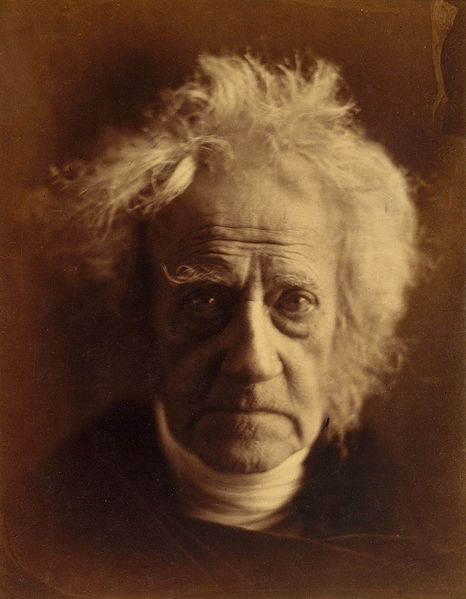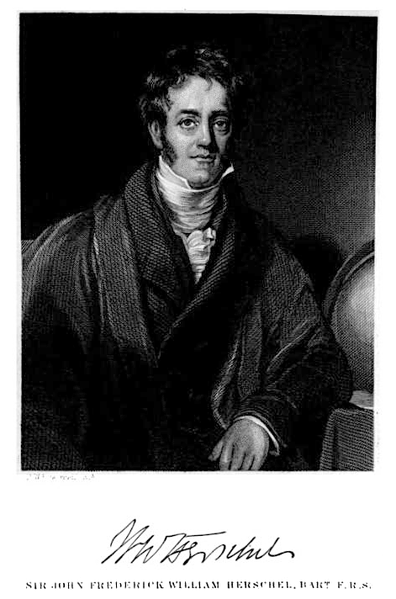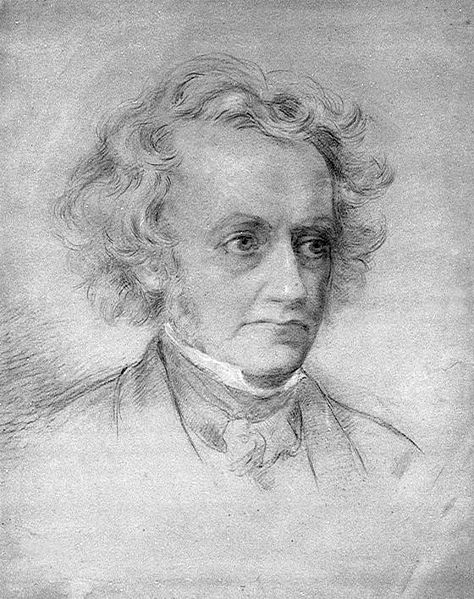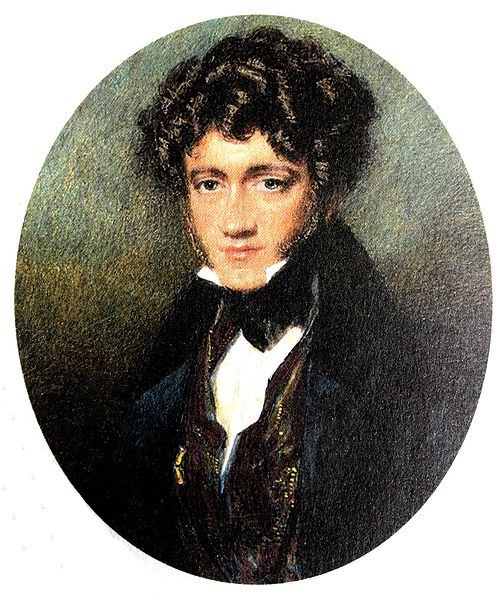<Back to Index>
- Astronomer John Frederick William Herschel, 1792
- Composer Joseph Maurice Ravel, 1875
- Prince of the Palatinate - Simmern Johann Casimir, 1543
PAGE SPONSOR


Sir John Frederick William Herschel, 1st Baronet KH, FRS (March 7, 1792 – May 11, 1871) was an English mathematician, astronomer, chemist, and experimental photographer / inventor, who in some years also did valuable botanical work. He was the son of astronomer Sir Friedrich Wilhelm Herschel and the father of 12 children.
Herschel originated the use of the Julian day system in astronomy. He named seven moons of Saturn and four moons of Uranus. He made many contributions to the science of photography, and investigated colour blindness and the chemical power of ultraviolet rays. Herschel was born in Slough, Berkshire, and studied shortly at Eton College and St John's College, Cambridge. He graduated as Senior wrangler in 1813. It was during his time as an undergraduate that he became friends with Charles Babbage and George Peacock. He
took up astronomy in 1816, building a reflecting telescope with a
mirror 18 inches (460 mm) in diameter and with a 20 foot
(6.1 m) focal length. Between 1821 and 1823 he re-examined, with James South, the double stars catalogued by his father. For this work he was presented in 1826 with the Gold Medal of the Royal Astronomical Society (which he won again in 1836), and with the Lalande Medal of the French Institute in 1825, while in 1821 the Royal Society bestowed upon him the Copley Medal for his mathematical contributions to their Transactions. Herschel was made a Knight of the Royal Guelphic Order in 1831. His A preliminary discourse on the study of natural philosophy published early in 1831 as part of Dionysius Lardner's Cabinet cyclopædia set
out methods of scientific investigation with an orderly relationship
between observation and theorising. He described nature as being
governed by laws which were difficult to discern or to state
mathematically, and the highest aim of natural philosophy was understanding these laws through inductive reasoning,
finding a single unifying explanation for a phenomenon. This became an
authoritative statement with wide influence on science, particularly at
the University of Cambridge where it inspired the student Charles Darwin with "a burning zeal" to contribute to this work. He published a catalogue of his astronomical observations in 1864, as the General Catalogue of Nebulae and Clusters, a compilation of his own work and that of his father's, expanding on the senior Hershel's Catalogue of Nebulae. A further complementary volume was published posthumously, as the General Catalogue of 10,300 Multiple and Double Stars. Declining an offer from the Duke of Sussex that they travel to South Africa on
a Navy ship, Herschel and his wife paid £500 for passage on the
'S.S. Mountstuart Elphinstone', a ship of 611 tons, which departed from
Portsmouth on 13 November 1833. The voyage to South Africa was made in
order to catalogue the stars, nebulae, and other objects of the
southern skies. This was to be a completion as well as extension of the survey of the northern heavens undertaken initially by his father Friedrich Wilhelm Herschel. He arrived in Cape Town on 15 January 1834 and set up a private 21 ft (6.4 m) telescope at Feldhausen at Wynberg. Amongst his other observations during this time was that of the return of Comet Halley. Herschel collaborated with Thomas Maclear, the Astronomer Royal at the Cape of Good Hope, and the two families became close friends. However,
in addition to his astronomical work, this voyage to a far corner of
the British empire also gave Herschel an escape from the pressures
under which he found himself in London, where he was one of the most
sought after of all British men of science. While in southern Africa,
he engaged in a broad variety of scientific pursuits free from a sense
of strong obligations to a larger scientific community. It was, he
later recalled, probably the happiest time in his life. In an
extraordinary departure from astronomy, he combined his talents with
those of his wife, Margaret, and between 1834 and 1838 they produced
131 botanical illustrations of fine quality, showing the Cape flora.
John Herschel used a camera lucida to
obtain accurate outlines of the specimens and left the details to his
wife. Even though their portfolio had been intended as a personal
record, and despite the lack of floral dissections in the paintings,
their accurate rendition makes them more valuable than contemporary
collections. Some 112 of the 132 known flower studies were collected
and published as "Flora Herscheliana" in 1996. As their home during their stay in the Cape, they had selected 'Feldhausen', an old estate on the south-east side of Table Mountain.
Here he set up his reflector to begin his survey of the southern skies.
Intrigued by the ideas of gradual formation of landscapes set out in Charles Lyell's Principles of Geology,
he wrote to Lyell on 20 February 1836 praising the book as a work which
would bring "a complete revolution in [its] subject, by altering
entirely the point of view in which it must thenceforward be
contemplated." and opening a way for bold speculation on "that mystery
of mysteries, the replacement of extinct species by others." Herschel
himself thought catastrophic extinction and renewal "an inadequate conception of the Creator", and by analogy with other intermediate causes "the
origination of fresh species, could it ever come under our cognizance,
would be found to be a natural in contradistinction to a miraculous
process". He prefaced his words with the couplet: Taking a gradualist view of development and referring to the evolution of language, he commented The document was circulated, and Charles Babbage incorporated extracts in his ninth and unofficial Bridgewater Treatise, which postulated laws set up by a divine programmer. When HMS Beagle called at Cape Town, Captain Robert FitzRoy and the young naturalist Charles Darwin visited
Herschel on 3 June 1836. Later on, Darwin would be influenced by
Herschel's writings in developing his theory advanced in The Origin of Species.
In the opening lines of that work, Darwin writes that his intent is "to
throw some light on the origin of species — that mystery of mysteries,
as it has been called by one of our greatest philosophers", referring
to Herschel. Herschel returned to England in 1838, was created a baronet and published Results of Astronomical Observations made at the Cape of Good Hope in 1847. In this publication he proposed the names still used today for the seven then known satellites of Saturn: Mimas, Enceladus, Tethys, Dione, Rhea, Titan, and Iapetus. In
the same year, Herschel received his second Copley Medal from the Royal
Society for this work. A few years later, in 1852, he proposed the
names still used today for the four then known satellites of Uranus: Ariel, Umbriel, Titania, and Oberon. Herschel made numerous important contributions to photography. He made improvements in photographic processes, particularly in inventing the cyanotype process and variations (such as the chrysotype), the precursors of the modern blueprint process.
He experimented with color reproduction, noting that rays of different
parts of the spectrum tended to impart their own color to a
photographic paper. He collaborated in the early 1840s with Henry Collen,
portrait painter to Queen Victoria. Herschel originally discovered the
platinum process on the basis of the light sensitivity of platinum
salts, later developed by William Willis. Unaware that the term photography had already been coined by Hercules Florence in 1834, Herschel also coined the term in 1839. He applied the terms negative and positive to photography. He discovered sodium thiosulfate to be a solvent of silver halides in 1819, and informed Talbot and Daguerre of his discovery that this "hyposulphite of soda" ("hypo") could be used as a photographic fixer,
to "fix" pictures and make them permanent, after experimentally
applying it thus in early 1839. His ground breaking research on the
subject was read at the Royal Society in London in March 1839 and
January 1840. Herschel
wrote many papers and articles, including entries on meteorology,
physical geography and the telescope for the eighth edition of the Encyclopædia Britannica. He also translated The Iliad of Homer. He invented the actinometer in 1825 to measure the direct heating power of the sun's rays, and his work with the instrument is of great importance in the early history of photochemistry. He
proposed a correction to the Gregorian calendar, making years that are
multiples of 4000 not leap years, thus reducing the average length of
the calendar year from 365.2425 days to 365.24225. Although this is closer to the mean tropical year of
365.24219 days, his proposal has never been adopted because the
Gregorian calendar is based on the mean time between vernal equinoxes
(currently 365.2424 days). In 1836, he was elected a foreign member of the Royal Swedish Academy of Sciences. In 1835, the New York Sun newspaper wrote a series of satiric articles that came to be known as the Great Moon Hoax, with statements falsely attributed to Herschel about his supposed discoveries of animals living on the Moon, including batlike winged humanoids. Herschel Island (in the Arctic Ocean, north of the Yukon Territory), the village of Herschel in western Saskatchewan, Canada, Mount Herschel (in Antarctica) and the crater J. Herschel on the Moon are named after him. So is Herschel Girls School in Cape Town, South Africa, which commemorates his visit to the area.

